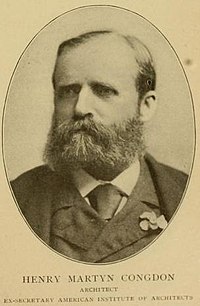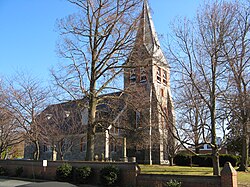Henry Martyn Congdon | |
|---|---|
 | |
| Born | May 10, 1834 |
| Died | February 28, 1922 (aged 87) Brooklyn |
| Alma mater | Columbia College |
| Occupation | Architect |
| Years active | 1854–1922 |
| Awards | Fellow of the American Institute of Architects (1867)[1] |
| Buildings | St. Andrew's Episcopal Church, Harlem St. Michael's Episcopal Cathedral, Boise |
Henry Martyn Congdon FAIA (May 10, 1834 – February 28, 1922)[1] was an American architect and designer. The son of an Episcopal priest who was a founder of the New York Ecclesiological Society,[2] he was born in Brooklyn, New York. In 1854, he graduated from Columbia College, where he was a member of Psi Upsilon.[3]
Congdon was apprenticed to John W. Priest,[4] and following Priest's death, assumed his practice, located at the time in Newburgh, New York. He moved the practice to Manhattan, cooperating for a time with Emlen T. Littell and J. Cleveland Cady.[5] Together with Cady he designed the Brooklyn Academy of Design in the High Victorian Gothic mode.[6] Congdon later practiced alone, until he was joined by his son, Herbert Wheaton Congdon. He resided in Brooklyn at the time of his death.
Specializing in churches, he designed numerous Episcopal churches during his career, mainly in the Gothic Revival tradition.
During the Civil War, he served as a member of the 7th Regiment. During his career, he was Vice President of the Brooklyn Academy of Arts and Sciences, and Secretary of the American Institute of Architects.


- ^ a b "Henry M. Congdon". AIA Historical Directory. American Institute of Architects. Retrieved 23 December 2022.
- ^ "Answers - the Most Trusted Place for Answering Life's Questions". Answers.com.
- ^ Obituary, The New York Times.
- ^ Stanton, Phoebe B., The Gothic Revival & American Church Architecture (Baltimore, 1968), 187n
- ^ "Connecticut Trust for Historic Preservation". Archived from the original on 2018-03-18. Retrieved 2010-10-28.
- ^ "The Illustrations," American Architect and Building News 1 (Jan. 29, 1876), 40.